Sales Enablement Solutions
According to research company Aberdeen, 84% of sales reps achieve their quotas when their company uses a best-in-class sales enablement strategy (as compared to 50% without). To best enable your sales team, start with a sales engagement platform that accomplishes the following:
Best practices
systematization.
Implement scalable processes that produce results and minimize reps’ administrative task time. Create cadences that take advantage of the best sales behaviors in your organization.
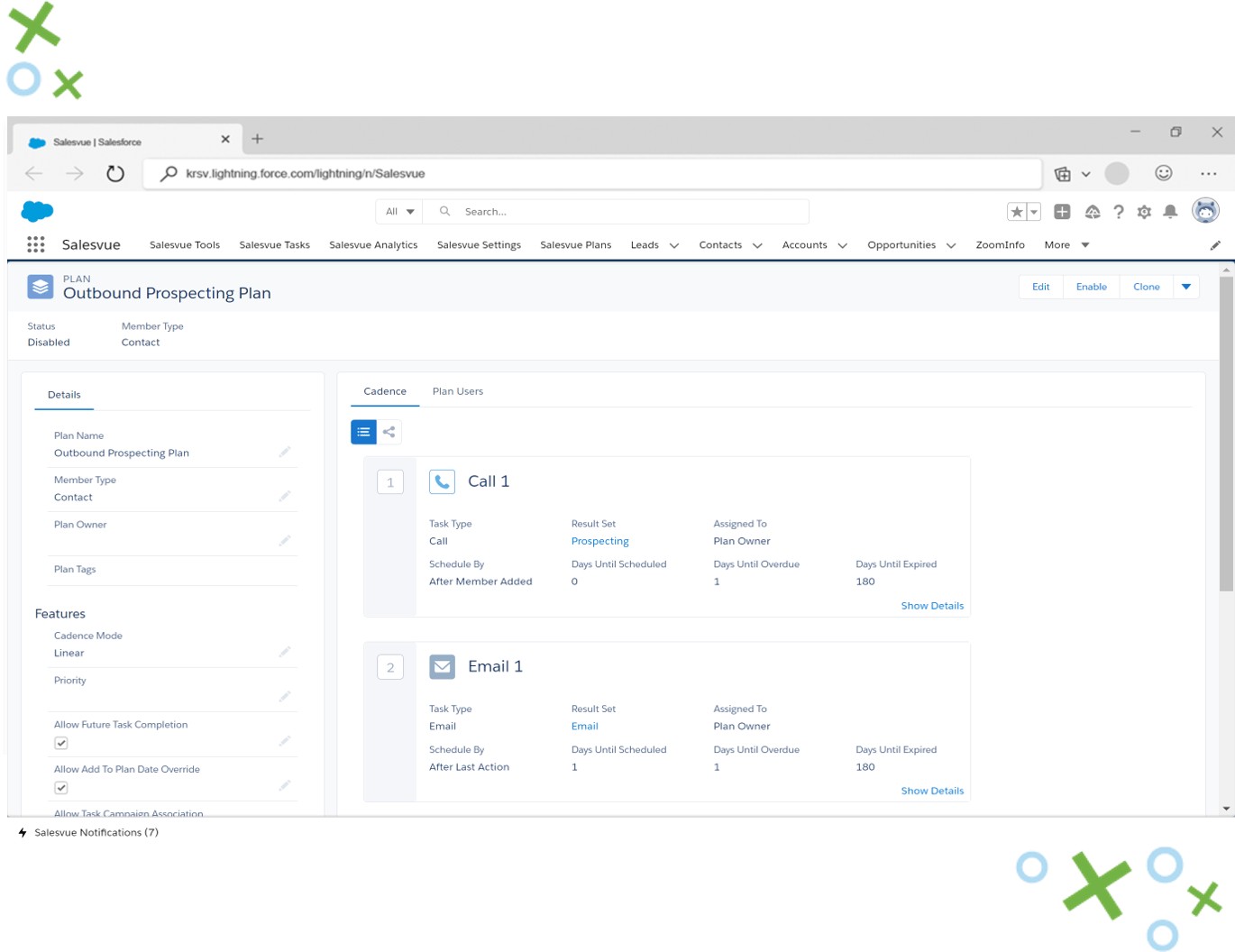
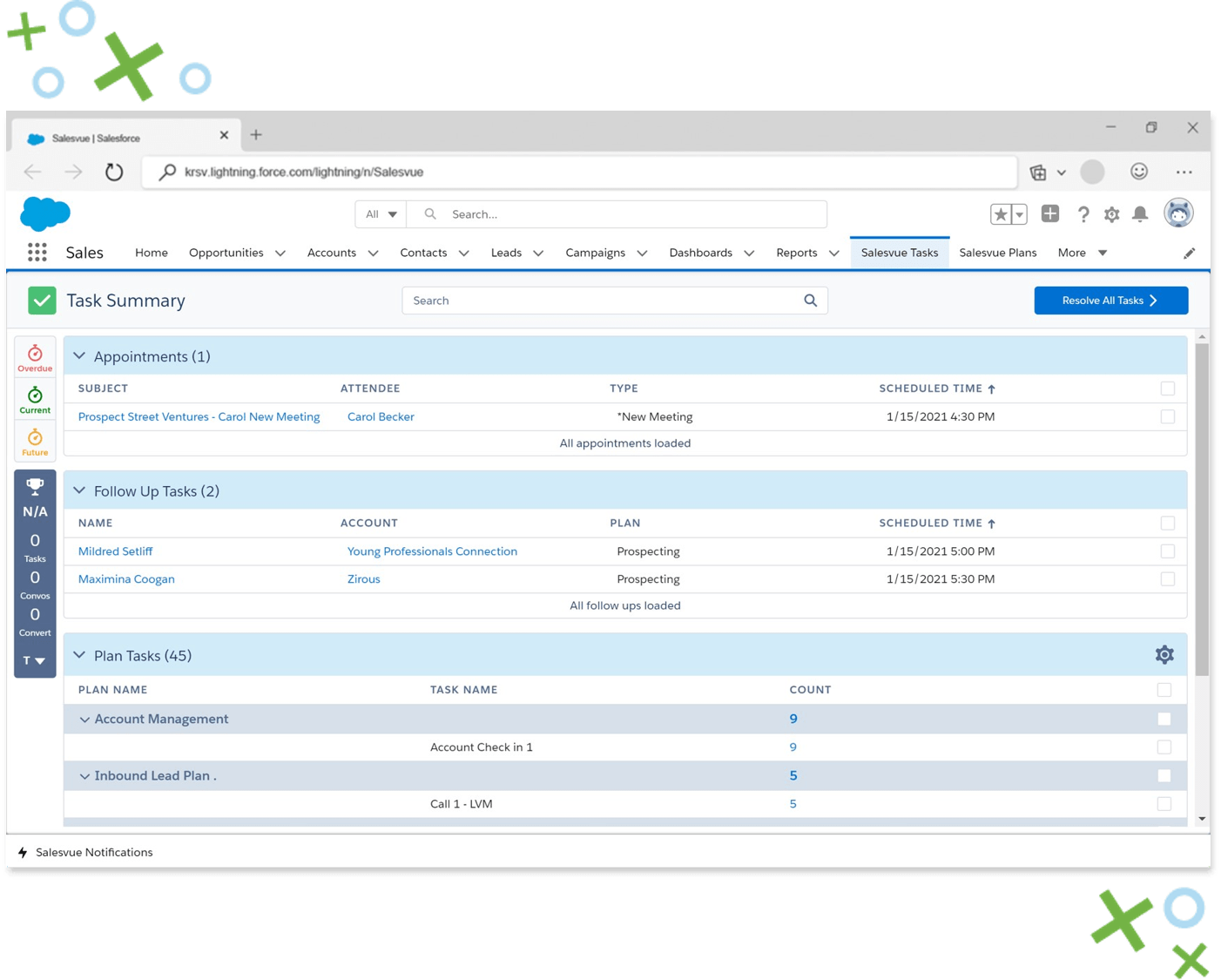
Easier Salesforce adoption.
Salesforce is a powerful selling tool if your reps use it. Increase Salesforce adoption by using a Salesforce-native sales engagement platform. With everything in one place for sales rep communication tasks and appointments, they will have more time to sell, and Salesforce data will be up-to-date at all times.
Improved training and development.
Use automated workflows and cadences, so new hires don’t have to wonder about who to contact, what to say, or how to engage prospects. And continue sales rep development by creating cadences that take advantage of the best sales behaviors in your organization to help turn “B” performers into “A” performers.
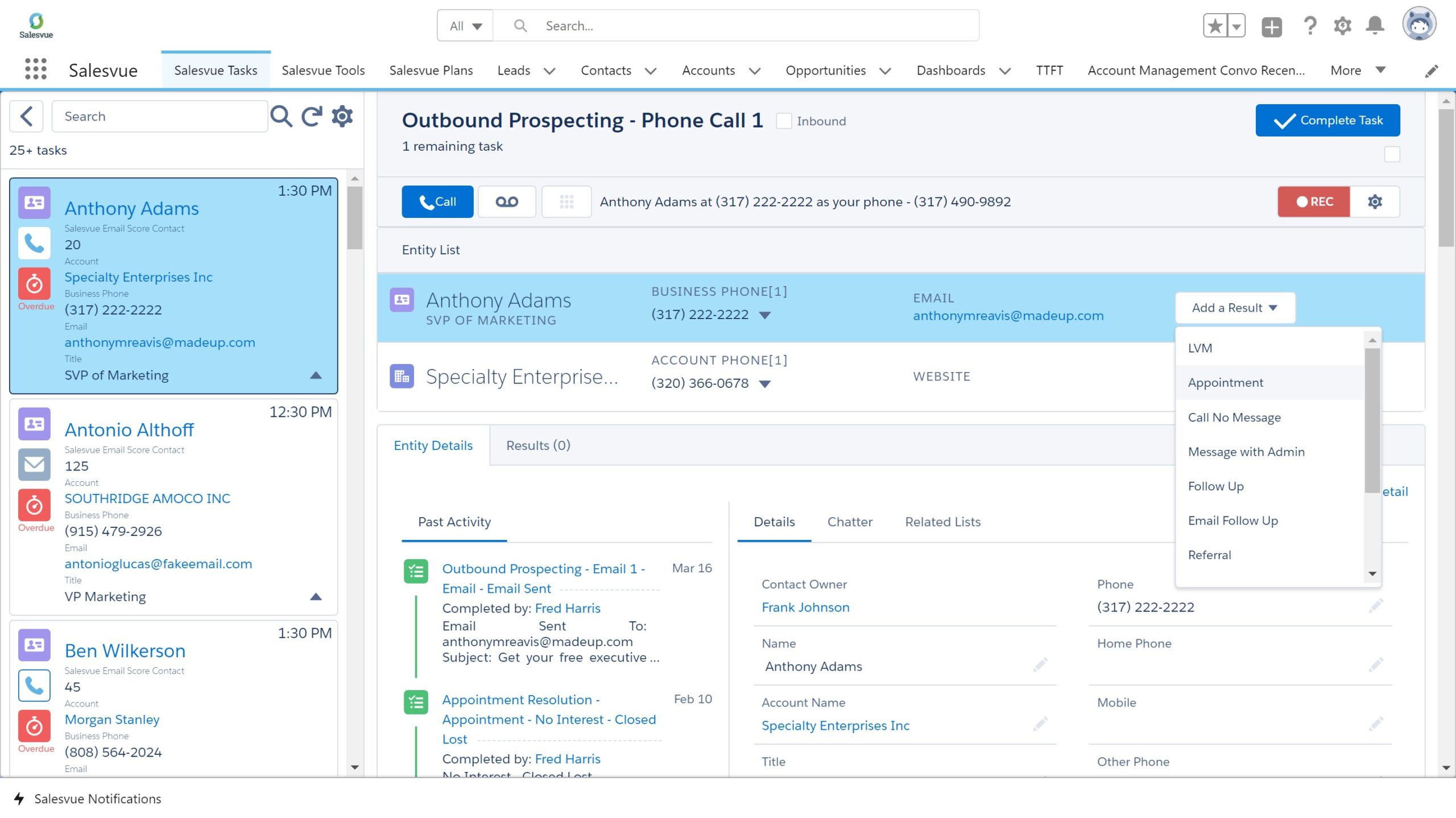
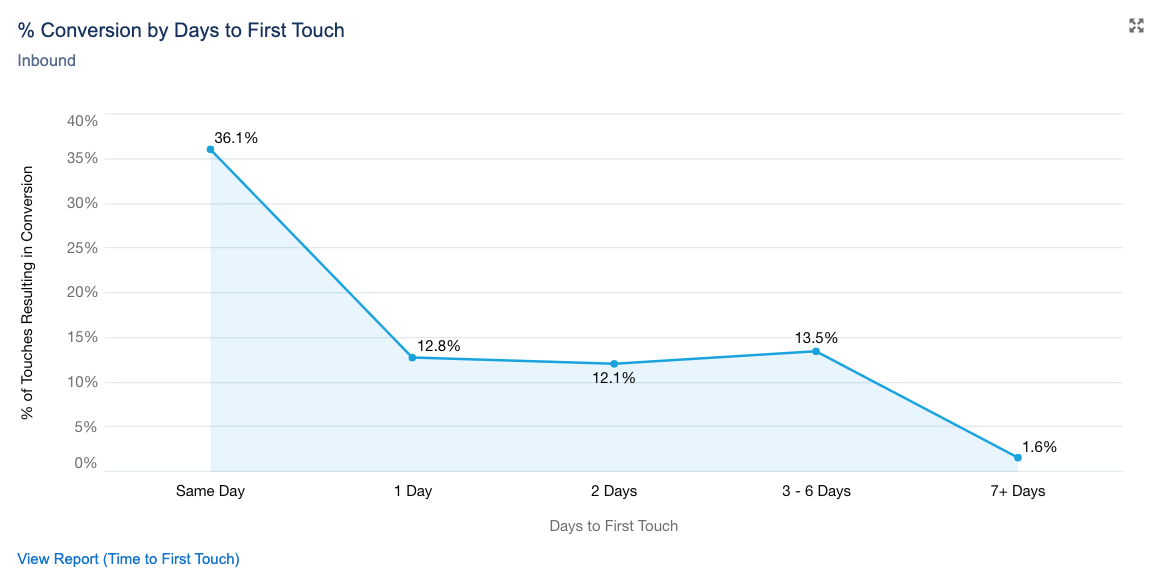
Sales and marketing
alignment.
Sales reps need quality content, and marketing needs to know that the leads they generate are getting a follow-up. Alignment is created when everyone has visibility into the sales cadence and which stage of the funnel a prospect is in, so they can work together to send specific messaging to prospects based on their current situation.
Metrics that matter.
Reports are only as good as the insights you get for improving. It’s important to use metrics that matter. For example, metrics that help you tie sales activities to marketing initiatives help the sales operations team identify what results in more wins. And identifying which reps have the best performance and follow-up times will let you scale their behaviors across the team, resulting in a higher performance team.
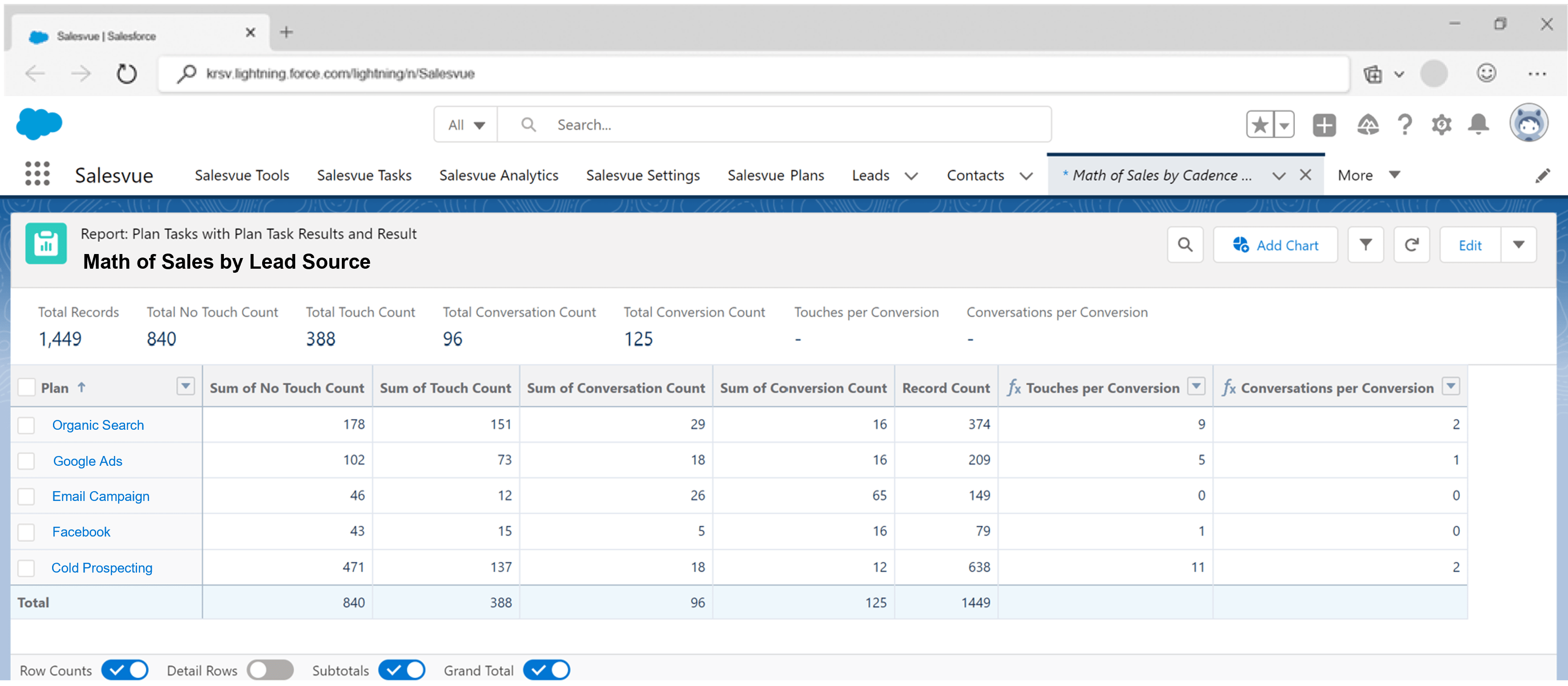
See how Salesvue can provide the playbook for your team, make Salesforce work better for you, and give you more insightful analytics.
Request a demoWhat Is Sales Enablement?
As sales enablement is garnering increasing interest from top companies, questions abound. Is sales enablement part of marketing? No, but marketing can be considered part of sales enablement. Is sales enablement the same as sales training? Again, no, but sales training should be provided in your sales enablement strategy.
If you are looking for a sales enablement meaning, you will quickly find more than one definition. However, they all are based on giving sales reps the resources they need to close more deals.
According to Hubspot, “Sales enablement is the iterative process of providing your business’s sales team with the resources they need to close more deals. These resources may include content, tools, knowledge, and information to effectively sell your product or service to customers.”
What Are The Components Of Sales Enablement?
According to Gartner, there are five best practices for sales enablement. They are:
- Define specific objectives.
- Focus on buyer experience.
- Create high-quality content.
- Make sales training a continuous effort.
- Ensure salespeople leverage what you provide.
Here is why these elements of sales enablement are important:
Define specific objectives. Without end goals, the path to success is not clear. What will result from you giving your sales reps the tools they need to be competitive in the marketplace? Some objectives may be:
- Turn your “B” performers into “A” performers by replicating the
behaviors of your top salespeople. - Decreasing onboarding time for new reps
- Decreasing time to first touch (rep follow-up time)
Focus on buyer experience. You want to make sure you are saying the right things at the right time to your prospects and customers. Set cadences and plan your content and calls around where they are in their journey.
Create high-quality content. Content such as blog posts, infographics, eBooks, and webinars should also be used with the buyer’s journey in mind. Moreover, your content should be helpful and relevant to the prospect or customer’s needs. Remember that content is not advertising.
Make sales training a continuous effort. According to Gartner’s research, B2B sales reps forget 70% of the information they learn within a week of training, and 87% will forget it within a month. No matter how busy you get, don’t lose sight of this statistic and provide training for your salespeople on a continuous basis.
Ensure salespeople leverage what you provide. You will have no idea if your sales enablement program is effective or how to improve it if your sales reps aren’t consistently using the tools you provide. While it’s impossible to watch everyone all the time, it is not difficult to take a few minutes to look at sales reps’ data (provided you have a sales engagement platform with strong analytics tracking the information).
Building A Sales Enablement Framework
In order to create a sales enablement process, start with a framework. A sales enablement plan should be phased in and might look something like this:
Phase 1: Assess (15-30 days)
- Examine the current sales process and make a note of what is working well and what needs improvement. The last thing you want to do is eliminate something that is helping sales reps reach their goals.
- Take an inventory of the current sales tools and their adoption rate. If you are using Salesforce as your CRM, are your sales reps using it consistently? If you are using a sales engagement platform, does it work seamlessly with your Salesforce instance?
- What are your top sales reps doing? What behaviors are
contributing to their success? How can you replicate these best practices with other lower-performing reps?
Phase 2: Plan (15-45 days)
- Create objectives that are tied to outcomes that you want to achieve. Do sales reps need to make a certain number of calls? Do they need to follow up with customers in a certain amount of time? If you want to increase revenue by a certain percentage, what specifically must happen?
- Identify key drivers for improvement. What content will you use at which point in the buyer’s journey? Which days of the week and which times are best to contact certain prospects and customers?
- Establish metrics that are meaningful to sales reps as well as leadership. It’s essential to get buy-in across the organization, and if everyone understands how analytics can provide actionable insights, it will be easier to get everyone on board.
Phase 3: Act (30-90 days)
- This phase may take one to three months to establish the new process and make sure it is being practiced consistently throughout the organization.
- Maintain frequent communication with all stakeholders and
encourage them with anecdotes of quick wins you have gained so far.
Phase 4: Measure (1-15 days)
- Review the metrics collected to date.
- See what’s working and what’s not and make adjustments.
- Use the data collected to coach sales reps.
How To Tell If You Have The Right Sales Enablement Metrics
You may already have a set of metrics that you commonly review, but are they metrics that matter? Do your metrics use existing Salesforce data and tie sales activities to marketing initiatives, so the sales operations team can identify what results in more wins?
Reconsider your metric if you answer “no” or “maybe” to the following questions.
- Does the metric lead you to make a decision and take action? The metric should help you determine if what you are doing is working or not so that you can adjust your sales and marketing strategies.
- Can you consistently reproduce the same result? Are you comparing apples to apples? You need to be able to segment and filter out certain variables to make sure you are getting meaningful insights. For example, you may be comparing conversion rates across reps, but they have different size clients. The smaller clients may convert more quickly because they have smaller dollar purchases. In this case, you would want to filter your clients by revenue before comparing reps’ performance.
- Is the data accurate? If your data source isn’t consistent and reliable, neither is the metric. It’s important to have a single source of truth across your operations, sales and marketing teams.
Sales Enablement Kpis
Some of the best sales enablement KPIs are:
Sales Activity Metrics
Analyzing sales activity can give you insight into many factors that can make your sales team more efficient and effective. Using activity metrics, you can:
- Understand which days of the week are the best to contact prospects or clients.
- Generate more sales conversations by reaching them when they’re
more likely to respond.
Use day-of-week data to make the best use of sellers’ time and
maximize efficiency. - Adjust cadences to increase the likelihood of conversions.
Time to First Touch Metrics
Time to touch affects conversion rates. By monitoring the time between adding a Lead, Contact, Account, or Opportunity and the time that the first communication (touch) is made to the prospect or lead, you can accomplish the following:
- Be sure your reps are following up on marketing qualified leads by
showing the average hours to first touch. - Filter results to show calls, emails, or both, so you know what method of follow-up is most successful.
- Identify which reps have the best follow-up times and scale their
behaviors across the sales team.
Lead Generation Metrics
Knowing what content is working and what is not can help the marketing team narrow its focus. Metrics can also confirm what the sales team is saying about the effectiveness of the content. Lead generation metrics help you:
- Compare which campaigns are performing best.
- Align the content with the buyer’s journey.
Conversion Metrics
Use various conversion metrics to:
- Identify the level of effort needed to generate a sales conversation and conversion by geographic territory.
- Identify who to target based on what content generates conversions by industry and job title.
- Understand which marketing channels or lead sources best convert to sales opportunities.
Sales Rep Performance Metrics
Compare sales reps’ activities and conversion rates so you can identify your top performers’ behaviors and leverage them by scaling their best practices across the organization.
Why Is Sales Enablement Important?
It Aligns Your Sales and Marketing Teams
Although both teams want the same thing (increased revenue, more parties, and pride), there exists a notorious rivalry between Sales and Marketing. It often goes something like this: Marketing says Sales isn’t following up on leads, and Sales says Marketing isn’t finding enough qualified leads. In order to be most effective, the departments need to work together. By creating a single source of truth and sharing data, Sales and Marketing teams can align. Sales enablement allows for this process to become much easier and helps provide the right content at the right time to the right people.
It Provides Smooth Onboarding of New Sales Reps
Research for Glassdoor by Brandon Hall Group found that organizations with a strong onboarding process improve new hire retention by 82 percent and productivity by over 70 percent. Without a solid onboarding experience, new hires don’t have the confidence needed to do their job effectively. With a sales enablement plan, onboarding is a priority. With such a plan, employers have a place where all the onboarding information, such as scripts, sales playbooks, competitor overviews, client reports, and other information made to help SDRs, can live. Plus, the time to ramp up a new hire is significantly reduced, resulting in more time selling and closing deals.
It Informs Best Practices
Every organization has that one or two sales reps that just crush it. A sales enablement plan will consider what makes the highest performing sales reps stand head and shoulders above the other sellers and allow you to scale their best practices. Sales enablement can help you scale by letting you define an activity or series of activities you want your team members to follow and automatically triggering other activities based on certain outcomes.
Signs That You Need Sales Enablement
Sales Reps are Not All Following the Same Process
Sales enablement helps get sellers on the same page. With a sales enablement strategy in place, sales teams have workflows that are consistent among all reps to ensure they are doing the same process and completing the same tasks. With the same workflow being used by everyone, it is easier to see what is working and what is not.
Sales Scripts are Inconsistent Across the Team
According to Forbes, 70 percent of the most successful US companies provide a consistent sales message throughout the entire buying journey, compared to just 37 percent of all the other companies. Sales enablement plans ensure that consistent scripts are being used across the organization, so you can deliver a consistent, reliable experience to your prospects and customers.
Conversion Rates are Down, Quotas Aren’t Being Met, and You Don’t Know Why
A sales enablement plan includes a reliance on metrics. Because a successful sales enablement plan will have one source of truth (one source of data), the metrics become undeniably accurate. With the analytics, you can identify areas needing improvement and make necessary adjustments to best practices, content, and cadences.
Sales Enablement Strategy Tips
- Involve the sales team in content creation. Knowing that a prospect or customer will have different needs at each point in the buyer’s journey, you will need different types of content. Sales reps know the customer the best and have valuable input. They can inform what types of content may be most useful and what objections their prospects have most often during the sales process.
- Regularly review metrics with both Sales and Marketing teams. Each month, get the teams together to go over what content is working and what you may want to drop and generate ideas for new content based on the ever-changing marketplace.
- Build your sales enablement plan with your top sales performers. Top sales reps may be resistant to a sales enablement plan if they think you are going to change the way they do things. If they have some “say” in the plan, they may not only advocate for the plan, they may think of ways to motivate the team that you hadn’t.
- Create a culture of enablement. When a salesperson closes a deal, and it can be attributed to sales enablement, celebrate. The more success your teams see as a result of your sales enablement efforts, the more invested they will be in the plan.
Sales Enablement Content
Provide content aligned with the buyer’s journey for your sales team. Here is a sample sales enablement content strategy.
Buyer Stage: Awareness
What gets prospect/customer attention: Thought leadership
Rationale: Buyers don’t know you yet, and they may not even be looking for your types of products and services. Giving them marketing trends and insights related to their industry helps position you/your organization as an expert in the industry. When they are ready to buy, you will be top of mind, and you are a credible source.
Content Types:
- eBooks/whitepapers
- Blog posts/articles
- Emails/newsletters
- Social media posts
Buyer Stage: Purchase Stage
What gets prospect/customer attention: Sales-oriented details
Rationale: At this point in the journey, buyers have narrowed the field significantly, and you probably aren’t competing much. While the sales rep still needs sales and marketing materials at this stage, content marketing has mostly served its purpose.
Content Types:
- Brochures
- Datasheets/Pricing information
- Timelines
- Estimates
- Contracts
Sales Enablement Platform
A sales enablement platform is a software or system in which departments throughout the organization work together to ensure the sales team’s success.
According to Salesforce, organizations need to focus on four primary categories to ensure the sales team’s success: recruiting and hiring, training and coaching, equipping, and assessing.
Recruiting and hiring. Not only do you need to get people with the right skill set, but you also need to get enough of them. And according to LinkedIn, “75% of job seekers consider an employer’s brand before even applying for a job.” So put your best foot forward and make sure you let your culture show through on your social media and “About” page of your website. While a sales enablement platform doesn’t have recruiting and hiring functions, it may be able to reveal the traits and behaviors of a good sales rep. For example, with Salesvue’s Math of Sales™, you can eliminate faulty assumptions that sales managers often have regarding who their best salespeople are.
Training and coaching. No matter the employee’s experience or skillset, onboarding, training, and coaching are required to educate and motivate reps within your organization. A sales enablement platform has a central repository for call scripts, sales playbooks, competitor overviews, client reports, and other information that helps onboard new reps.
Equipping. You must provide reps with the right tools to do their jobs. This is quite broad and includes a CRM, email tools, call tools, and content. Often several tools are part of a sales enablement platform.
Assessing. You need to measure who and what is performing best. Which cadences result in the best contact rate? Which campaigns and content result in the most prospect interaction? Which sales reps have the highest conversion rates? Look for analytic reports in your sales enablement platform that help you answer these questions.
Other Resources Links
- Sales enablement strategy
- Sales enablement KPIs
- Sales enablement with Salesforce
- Sales enablement framework
- Sales enablement platform
- Sales enablement vs sales engagement
- Sales enablement best practices
- Sales enablement process
- Sales enablement training
- Sales enablement tools
- Sales enablement materials
